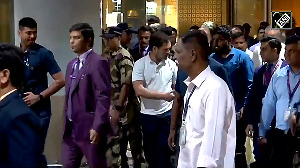The departure of Tata Motors from Singur has left two unanswered questions - who gains in the political sweepstakes from this event and, inextricably linked to it, what decision will be taken on the land which was at heart of the Singur conflict, for that would determine the fallout.
The CPI (M) is reasonably confident that the overwhelming majority of people in West Bengal back the agenda of industrialisation launched by Chief Minister Buddhadeb Bhattacharjee.
The party's slogan in the 2006 assembly elections was "agriculture is the foundation, industry the next step" and this had swept it to power.
Pundits at Alimuddin Street refuse to believe that voters have changed their mind since.
The evidence tends to support this viewpoint.
First, let's look at the local impact.
In Singur, a stronghold for years of the opposition Trinamool Congress, 10,000-odd farmers surrendered their land willingly to the West Bengal Industrial Development Corporation, out of a total of 12,200 whose lands were acquired for the Nano factory.
In other words, even in opposition-dominated areas, the majority supported industrialisation in 2006, losing valuable farmland (like the plots at Singur) to a factory, and that too at a price that looked attractive in July 2006 but is half of the market rate in July 2008, and as the recent suicides prove, far less than even what a farming family needs to survive for three-four years.
Even willing farmers in Singur admit that the money they received was not enough for a period more than 18-20 months, and has been in fact eaten away faster than expected by inflation and eroded by their lack of expertise in handling the cash they received in compensation.
Now, with the factory gone, they cannot expect to make the income they expected to make from 2009 onwards by setting up small supply shops or other commercial establishments servicing the factory.
In other words, their capital is gone and so is virtually any chance of replenishing it from fresh income dependent on the factory.
So who do they blame for their predicament?
The Trinamool, of course.
Today, these "willing" farmers want the Tatas back, and have been demanding that Mamata Banerjee and West Bengal Governor Gopal Krishna Gandhi help in this.
The 2,000-odd "unwilling" farmers who did not accept compensation though they lost their land to the 997-acre factory, and whose cause was being championed by Mamata Banerjee's TC and its 20 allies, face a worse future.
They lost their income from agriculture as their land vanished behind the factory wall, and did not enjoy the cushion provided by the compensation paid in 2006.
Through their long struggle to make ends meet from July 2006, they stood by Mamata Banerjee in the hope that she would get them back their land or at least a much more favourable compensation package.
Today, with these hopes gone, their future is darker than that of their "willing" counterparts.
Mamata appears to have ruined any chances of getting the benefits that they expected to see at the end of their struggle.
That's round-II to the Left as well.
This brings us to the two possible alternatives on the land issue.
One, the Tatas can return the land and a new factory, more suitable to the undisputed 650-acre part of the 997-acre plot, comes up there to restart economic activity in the area. The dispute over the balance acres, which the unwilling and their leaders want back, can then continue to be the subject of the legal dispute now before the Supreme Court, or be settled through negotiations over time.
This would make the majority warm up to the CPI(M), though the "unwilling" were likely to continue to protest and Tata Motors would be less than happy for sure.
The second one is to cancel the entire project plan for the area and offer the land back to the farmers at the price at which it was acquired from them, with the money being recovered as and when they can raise the sum through mortgage or direct lease or sale to settle the government claim.
Here, the unwilling would enjoy an advantage for they would get their land back without a claim hanging over their head, and therefore, likely to face resistance from the community of the willing.
The CPI (M), ever vigilant against solutions that help an opponent, knows very well that if this is done, willing farmers could then reap the benefits of higher land price, even for land ruined by the factory, through sale to commercial users, while Mamata's unwilling would get back their land for farming or any other chosen activity. This will go to Trinamool's credit and keep its flag flying high in Singur, something that the CPI(M) will want to avoid at any cost.
Now for the impact when viewed from the non-local perspective.
Across the state, the combined impact of the police firing in Nandigram on March 14, 2007, which killed 14 people, and earlier the Singur land acquisition of 2006, done after invoking Section 144 and banning protests, sent shudders down the collective spine of farmers, who now see the state as a machine that acquires land and takes decisions (like setting up a chemical zone in Nandigram) without discussing either the decision or the terms of compensation.
Both have now been undone and opponents to such a state approach appear to have won, but the fruits of this victory appear to be most unlikely to last till the next assembly elections due in 2011.
The current misery of the "unwilling" at Singur is only likely to intensify as months pass and the stalemate on return of land to them continues, even as the willing use their surviving capital to keep their heads above water.
The divided community would serve as an example of what the Left would market as the impact of mindless opposition, of Trinamool actions that killed the goose that could lay the golden egg.
Just as Nandigram has gone back to its sleepy days of growing paddy amidst sporadic violence, under a newly-elected Trinamool gram panchayat, a Trinamool MLA of 2006 vintage and a CPI (M) member of Parliament, Singur is in danger of relapsing into its agricultural existence.
While the Trinamool will highlight the pleasures of status quo, the Left will harp on the opportunity missed by these communities to upgrade into the industrial age when the Parliamentary elections come up in 2009, or before.
The Left and CPI (M) are nervous about the short-term impact in the race for Sansad Bhavan, but so are their opponents.
The vast majority of urban dwellers backs the pro-industry drive of the CPI(M) and so do many of the rural populace who see fragmented land holdings and fluctuating crop prices and returns as a poor alternative to factory jobs or self-employment opportunities.
The setbacks in the May 2008 panchayat elections notwithstanding, the CPI (M) and the Left will attempt to pillory the Trinamool and the Congress for their similar agenda on Singur.
The danger that the Left faces is anti-Left votes getting united under a joint Congress-Trinamool banner, as indicated by the recent Sonia Gandhi-Mamata Banerjee meeting, but if it plays its cards well, the people of West Bengal look set to elect the Left back to Parliament.
Given that Left unity today is stronger than it has been in the recent past, and the Congress-Trinamool alliance is yet to be even taken up by Bengal Congress president Priya Ranjan Das Munshi, the dice appears to be loaded heavily in favour of the Red brigade.







 © 2025
© 2025